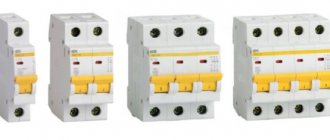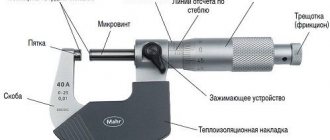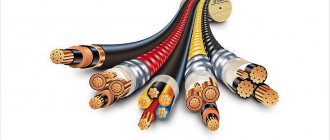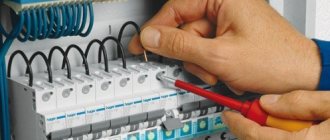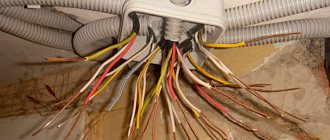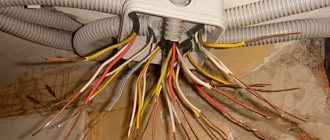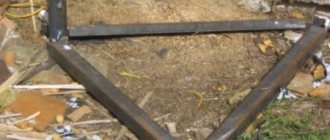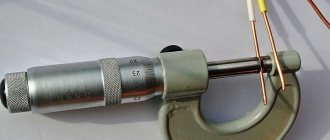SIP (stands for self-supporting insulated wire) is a multi-core wire for main overhead power lines and linear branches from them.
Usually includes 4 wires twisted during manufacture, where one is the carrier wire, and the rest are intended for each of the 3 phases.
Also, the supporting core may be absent altogether, and the number of conductors may vary from 1 to 4. The threshold values of all characteristics of self-supporting wires are standardized by GOST R 52373 - 2005, and the specific values from different manufacturers may vary slightly.
Wire installation
The technology for installing SIP wires does not present any particular difficulties. Thanks to this, with the proper skill and free time, you can complete all the work yourself. But in order to install the SIP cable yourself, you must first coordinate the work with government services. In addition, before you begin installing the SIP wire to the house, you need to obtain permission from the company supplying electricity. In order to correctly carry out all work on connecting the line, you need to carefully study the recommendations of specialists. The step-by-step instructions for installing SIP wires say: 1. First of all, you need to select a product of the required cross-section. Most often, for installing SIP cables from a pole to a house, products with a cross-section of 15 mm are used. 2. If the extension line exceeds 25 m, you will need to install additional support and use a tensioner.
3. In the case when it is necessary to branch the SIP cable line, additional components will be needed for installation - a special clamp. With its help, you can make punctures on the pole in the right places. The advantages of using clamps include simplified installation - you will not need to strip the cable. Next, the installation of the SIP cable from the pole to the building is carried out according to the following plan: 1. Attach special fasteners to the support. Fasteners are necessary to ensure a strong connection. 2. Install the clamp. To do this, among the components for installing SIP wires there must be an anchor-type clamping device. It is a fitting with a bracket. 3. If wood was used for the construction of the building, according to the rules for installing SIP cables, additional insulation of the wire must be performed. To carry out wiring to stone or brick houses, there is no need to additionally insulate the wire. 4. Lead the wire 1 m into the building. 5. Make a branch inside the house. To correctly install SIP wires inside a building, you can watch a video. If necessary, a special coupling may be required to connect the cables.
Production and sales
There are many cable manufacturers, and only the consumer can decide which wire to choose specifically from all the varieties. As for quality, it cannot be said that any of the large domestic or foreign manufacturers are significantly higher or lower in this indicator.
All requirements for SIP wires are presented in the relevant GOST, and if the products of a particular enterprise do not comply with it, they simply will not reach the market.
The manufacturer directly carries out mainly wholesale cable sales; for small volumes you will have to resort to the services of dealers or intermediaries. And decent companies are always ready to provide documentation confirming their cooperation with one or another manufacturer, as well as evidence of the quality of the product.
How many kilowatts will SIP withstand?
While browsing the internet for electrical installations, I found a thread on one forum discussing “whether a 4x16 sip can withstand 15 kW.” The question arises because 15 kW 380 volts are allocated for connecting a private house. Well, people are wondering if it’s not enough to lay 16 square meters on a branch from the overhead line? I first looked into the PUE, but for some reason I didn’t find anything there on the topic of SIP power.
There is only plate 1.3.29 “Permissible long-term current for non-insulated wires according to GOST 839-80.” And it shows that the maximum permissible current for the cross section is 16 kV. mm. wire type AC, ASKS, ASK outdoors is 111 amperes. Well, at least something to start with.
How many kilowatts can a 4x16 SIP withstand?
But there is GOST 31943-2012 “Self-supporting insulated and protected wires for overhead power lines.” At the end of the standard, in paragraph 10 of the operating instructions, there is a sign
How many kilowatts can SIP withstand - table:
SIP section voltage 380V (3-phase load) voltage 220V (1-phase load)
| SIP 4x16 | 62 kW | 22 kW |
| SIP 4x25 | 80 kW | 29 kW |
| SIP 4x35 | 99 kW | 35 kW |
| SIP 4x50 | 121 kW | 43 kW |
| SIP 4x70 | 149 kW | 53 kW |
| SIP 4x95 | 186 kW | 66 kW |
| SIP 4x120 | 211 kW | 75 kW |
| SIP 4x150 | 236 kW | 84 kW |
| SIP 4x185 | 270 kW | 96 kW |
| SIP 4x240 | 320 kW | 113 kW |
Calculation method (update from 02/19/2018)
We take plate 10 and from it we find that one core is 16 sq. mm. withstands - 100 amperes. Next, we take the following calculation formulas:
for single-phase load 220V P=U*I
for three-phase load 380V P=(I1+I2+I3)\3*cos φ*1.732*0.38
update from 02/19/2018 Regarding the calculation of power for a three-phase load, you need to understand that a lot depends on the type of consumers (more precisely, what kind of load they provide active or reactive, it depends on what cos φ should be substituted into the formula, in this case for calculations it is equal to 0.95 )
Dear visitors to the site, I might not have noticed your caustic but technically correct comments on the article if just today a person called me with the question: “what kind of sip do I need for 120 kW?” According to the sign, a SIP with a cross section of 50 mm square would be perfect for him. Even if we omit the fact that the length of the line affects the voltage drop (it has 150 meters), we should not forget that the load on the phases can vary, as can be seen from the formula - it takes the average value for three phases. Here you just need to understand that the phase current can exceed the maximum permissible values for a given wire cross-section.
Therefore, if the value of the load you need is closer than 10% to the table, you should choose a larger section of the vulture from the list. Let me explain with the example of 120 kW. According to the table, for this three-phase load, a SIP with a conductor cross-section of 50 mm is suitable, but this is less than 10%. That is, 121 kW * 0.9 = 109 kW. Accordingly, you need to choose SIP 3x70+1x54.6.
At the beginning of the topic, the question was raised: “will a 4x16 15kW sip handle it?” Therefore, for a private house we multiply 220Vx100A = 22 kW per phase. But don’t forget that we have three phases. And this is already 66 kilowatts in total for a residential building. Which is a 4-fold margin relative to the issued technical conditions.
zakenergo.ru
Types of SIP cable
Wires are divided into 4 main types.
- SIP-1 and SIP-2 are applicable both for main overhead power lines and their branches, designed for a voltage of 0.6-1 kV. The load-bearing core in SIP-1 is uninsulated, unlike SIP-2.
- In SIP-3, the cores are made of aluminum alloy with insulation made of extruded polymers. Such wires are used for overhead power lines, where the rated voltage is 10, 20 or 35 kV.
- In SIP-4 there is no load-bearing conductor, therefore this type is used exclusively for linear branches of air mains and is laid along the surface of the walls of buildings and structures.
For regions with high humidity, special sealed wires are produced, correspondingly marked with the letter “g”. For them, GOST establishes requirements for resistance to the longitudinal spread of water. This indicator should not exceed 3 m along the wire from the point of its penetration.
Most manufacturers provide a 3-4 year warranty on self-supporting wires, and their service life must be at least 40 years.
Selecting the cable cross-section according to power
You can select the wire cross-section according to the power of the devices that will be connected. These devices are called load and the method can also be called “by load”. Its essence does not change from this.
The choice of cable cross-section depends on the power and current
Collecting data
First, find the power consumption in the passport data of household appliances and write it down on a piece of paper. If it’s easier, you can look at nameplates - metal plates or stickers attached to the body of equipment and equipment. There is basic information and, more often than not, power. The easiest way to identify it is by its units of measurement. If a product is manufactured in Russia, Belarus, or Ukraine, it is usually designated W or kW; on equipment from Europe, Asia or America, the English designation for watts is usually W, and the power consumption (this is what is needed) is designated by the abbreviation “TOT” or TOT MAX.
Example of a nameplate with basic technical information. There is something similar on any technology
If this source is also unavailable (the information has become lost, for example, or you are just planning to purchase equipment, but have not yet decided on the model), you can take the average statistical data. For convenience, they are summarized in a table.
Table of power consumption of various electrical appliances
Find the equipment you plan to install and write down the power. Sometimes it is given with a wide spread, so sometimes it is difficult to understand which figure to take. In this case, it is better to take the maximum. As a result, when calculating, you will slightly overestimate the power of the equipment and will need a cable with a larger cross-section. But for calculating the cable cross-section it is good. Only cables with a smaller cross-section than necessary will burn. Routes with a large cross-section work for a long time, as they heat up less.
The essence of the method
To select the wire cross-section for the load, add up the power of the devices that will be connected to this conductor
It is important that all powers are expressed in the same units of measurement - either in watts (W) or in kilowatts (kW). If there are different values, we bring them to a single result
To convert, kilowatts are multiplied by 1000 to get watts. For example, let's convert 1.5 kW into watts. This will be 1.5 kW * 1000 = 1500 W.
If necessary, you can carry out the reverse conversion - convert watts to kilowatts. To do this, divide the figure in watts by 1000 to get kW. For example, 500 W / 1000 = 0.5 kW.
Next, the selection of the cable cross-section actually begins. It's very simple - we use a table.
| Cable cross-section, mm2 | Conductor diameter, mm | Copper wire | Aluminum wire | ||||
| Current, A | power, kWt | Current, A | power, kWt | ||||
| 220 V | 380 V | 220 V | 380 V | ||||
| 0.5 mm2 | 0.80 mm | 6 A | 1.3 kW | 2.3 kW | |||
| 0.75 mm2 | 0.98 mm | 10 A | 2.2 kW | 3.8 kW | |||
| 1.0 mm2 | 1.13 mm | 14 A | 3.1 kW | 5.3 kW | |||
| 1.5 mm2 | 1.38 mm | 15 A | 3.3 kW | 5.7 kW | 10 A | 2.2 kW | 3.8 kW |
| 2.0 mm2 | 1.60 mm | 19 A | 4.2 kW | 7.2 kW | 14 A | 3.1 kW | 5.3 kW |
| 2.5 mm2 | 1.78 mm | 21 A | 4.6 kW | 8.0 kW | 16 A | 3.5 kW | 6.1 kW |
| 4.0 mm2 | 2.26 mm | 27 A | 5.9 kW | 10.3 kW | 21 A | 4.6 kW | 8.0 kW |
| 6.0 mm2 | 2.76 mm | 34 A | 7.5 kW | 12.9 kW | 26 A | 5.7 kW | 9.9 kW |
| 10.0 mm2 | 3.57 mm | 50 A | 11.0 kW | 19.0 kW | 38 A | 8.4 kW | 14.4 kW |
| 16.0 mm2 | 4.51 mm | 80 A | 17.6 kW | 30.4 kW | 55 A | 12.1 kW | 20.9 kW |
| 25.0 mm2 | 5.64 mm | 100 A | 22.0 kW | 38.0 kW | 65 A | 14.3 kW | 24.7 kW |
To find the required cable cross-section in the corresponding column - 220 V or 380 V - we find a figure that is equal to or slightly greater than the power we previously calculated. We select the column based on how many phases are in your network. Single-phase - 220 V, three-phase 380 V.
In the found line, look at the value in the first column. This will be the required cable cross-section for a given load (power consumption of devices). You will need to look for a cable with cores of this cross-section.
A little about whether to use copper wire or aluminum. In most cases, when laying wiring in a house or apartment, cables with copper conductors are used. Such cables are more expensive than aluminum ones, but they are more flexible, have a smaller cross-section, and are easier to work with. But copper cables with a large cross-section are no more flexible than aluminum ones. And under heavy loads - at the entrance to a house or apartment with a large planned power (from 10 kW or more), it is more advisable to use a cable with aluminum conductors - you can save a little.
Diameter of SIP wire cores
No wires for lighting:
| Number of cores and cross-section | Outer diameter of wire, mm |
| 1x16+1x25 | 17 |
| 3x16+1x25 | 22 |
| 3x25+1x35 | 26 |
| 3x35+1x50 | 30 |
| 3x50+1x50 | 33 |
| 3x50+1x70 | 35 |
| 3x70+1x70 | 38 |
| 3x70+1x95 | 41 |
| 3x95+1x70 | 43 |
| 3x95+1x95 | 44 |
| 3x120+1x95 | 47 |
| 3x150+1x95 | 49 |
| 4x25+1x25 | 22 |
| 4x25+1x35 |
With wires for lighting:
| Number of cores and cross-section | Outer diameter of wire, mm |
| 3x25+1x35+1x16 | 28 |
| 3х25+1х35+1х16(ozh) | 28 |
| 3x35+1x50+1x16 | 30 |
| 3x35+1x50+1x25 | 30 |
| 3x50+1x50+1x16 | 33 |
| 3x50+1x50+1x25 | 33 |
| 3x50+1x70+1x16 | 35 |
| 3x50+1x70+1x25 | 35 |
| 3x70+1x70+1x16 | 38 |
| 3x70+1x70+1x25 | 38 |
| 3x70+1x95+1x16 | 40 |
| 3x70+1x95+1x25 | 40 |
| 3x95+1x70+1x16 | 42 |
| 3x95+1x70+1x25 | 42 |
| 3x95+1x95+1x16 | 44 |
| 3x95+1x95+1x25 | 44 |
| 3x120+1x95+1x16 | 47 |
| 3x150+1x95+1x16 | 50 |
| 3x120+1x95+1x25 | 47 |
| 4x25+1x35+1x16 | 29 |
| 3x25+1x35+2x16 | 28 |
| 3x25+1x54.6+2x16 | 30 |
| 3x25+1x54.6+2x25 | 30 |
| 3x35+1x50+2x16 | 30 |
| 3x35+1x54.6+2x16 | 32 |
| 3x35+1x54.6+2x25 | 32 |
| 3x50+1x50+2x16 | 33 |
| 3x50+1x54.6+2x25 | 35 |
| 3x70+1x70+2x16 | 35 |
| 3x70+1x54.6+2x16 | 38 |
| 3x70+1x54.6+2x25 | 38 |
| 3x70+1x70+2x16 | 38 |
| 3x70+1x95+2x16 | 40 |
| 3x95+1x70+2x16 | 42 |
| 3x95+1x95+2x16 | 44 |
| 3x120+1x95+2x16 | 47 |
More articles
- The importance of calculating cable cross-section
- Recessed ceiling LED lights
- Cable channels of open wiring in residential and office premises
- NUM cable, description, application
- Flexible power cable KG: description, characteristics, purpose
- What cable trays are used in electrical installations?
- Terminal blocks for DIN rail: classification, photo
- Distribution box: description, types and types of distribution (junction) boxes
- Mounting boxes for electrical installation: classification and types
- Electrical trays: description, use, regulatory documents
Wire installation
The technology for installing SIP wires does not present any particular difficulties. Thanks to this, with the proper skill and free time, you can complete all the work yourself. But in order to install the SIP cable yourself, you must first coordinate the work with government services. In addition, before you begin installing the SIP wire to the house, you need to obtain permission from the company supplying electricity. In order to correctly carry out all the work on connecting the line, you need to carefully study the recommendations of specialists. The step-by-step instructions for installing SIP wires say: 1. First of all, you need to select a product of the required cross-section. Most often, for installing SIP cables from a pole to a house, products with a cross-section of 15 mm are used. 2. If the extension line exceeds 25 m, you will need to install additional support and use a tensioner.
3. In the case when it is necessary to branch the SIP cable line, additional components will be needed for installation - a special clamp. With its help, you can make punctures on the pole in the right places. The advantages of using clamps include simplified installation - you will not need to strip the cable. Next, installation of the SIP cable from the pole to the building is carried out according to the following plan: 1. Attach special fasteners to the support. Fasteners are necessary to ensure a strong connection. 2. Install the clamp. To do this, among the components for installing SIP wires there must be an anchor-type clamping device. It is a fitting with a bracket. 3. If wood was used for the construction of the building, according to the rules for installing SIP cables, additional insulation of the wire must be performed. To carry out wiring to stone or brick houses, there is no need to additionally insulate the wire. 4. Lead the wire 1 m into the building. 5. Make a branch inside the house. To correctly install SIP wires inside a building, you can watch a video. If necessary, a special coupling may be required to connect the cables.
Selection of SIP section
The selection and calculation of the cross-section of SIP wires for connecting various consumer objects is carried out using the classical method. The maximum power consumption of electrical installations is added up, and the current load is calculated using the formula:
– P – total power consumption;
– I – maximum current consumption;
– U – network voltage.
Based on the value of the maximum current, you should select the required cross-section of SIP wires using pre-calculated tables.
Parameters of the most used SIP cables for connecting buildings from the main power lines (SIP-1, SIP-1A, SIP-2, SIP-2A)
| branches from overhead lines; | for installation of overhead lines with voltage 6-35 kV | branches from overhead lines; | branches from overhead lines; | |
| Section in mm and number of cores | Phase resistance in Ohm per 1 km | Maximum permissible phase current with thermoplastic insulation | Maximum permissible phase current with cross-linked polyethylene | Short circuit current in kA for a duration of 1s |
| 1x16+1x25 | 1.91 | 75 | 105 | 1 |
| 2x16 | 1.91 | 75 | 105 | 1 |
| 2x25 | 1.2 | 100 | 135 | 1.6 |
| 3x16 | 1.91 | 70 | 100 | 1 |
| 3x25 | 1.2 | 95 | 130 | 1.6 |
| 3x16+1x25 | 1.91 | 70 | 100 | 1 |
| 3x25+1x35 | 1.2 | 95 | 130 | 1.6 |
| 3x120 +1x95 | 0.25 | 250 | 340 | 5.9 |
| 3x95+1x95 | 0.32 | 220 | 300 | 5.2 |
| 3x95+1x70 | 0.32 | 220 | 300 | 5.2 |
| 3x50+1x95 | 0.44 | 180 | 240 | 4.5 |
| 3x70+1x70 | 0.44 | 180 | 240 | 4.5 |
| 3x50+1x70 | 0.64 | 140 | 195 | 3.2 |
| 3x50+1x50 | 0.64 | 140 | 195 | 3.2 |
| 3x35+1x50 | 0.87 | 115 | 160 | 2.3 |
| 3x25+1x35 | 1.2 | 95 | 130 | 1.6 |
| 3x16+1x25 | 1.91 | 70 | 100 | 1 |
| 4x16+1x25 | 1.91 | 70 | 100 | 1 |
| 4x25+1x35 | 1.2 | 95 | 130 | 1.2 |
When choosing the cross-section and brand of SIP wires, it is important to take into account not only the maximum current load, but also the temperature and the time during which the cable can be operated in extreme conditions. Typically the allowable duration is 4000 to 5000 hours
Maximum temperature for wires
| Operating modes | Maximum temperature for wire | |
| Thermoplastic insulation SIP-1, SIP-1A, SIP-4 | Cross-linked polyethylene SIP-2, SIP-2A, SIP-3, SIP-5 | |
| norm | 70 | 90 |
| during overloads | 80 | 130 |
| in case of a short circuit lasting up to 5 seconds | 135 | 250 |
When choosing the brand of SIP cable and its heating cross-section, you must take into account the type of insulation: cross-linked polyethylene or thermoplastic. Taking into account voltage losses, thermal resistance during short circuit, mechanical strength, if one of the parameters is insufficient, a cable with a large cross-section is selected.
When operating a SIP cable, overloads are allowed up to 8 hours a day, 100 hours a year and no more than 1000 hours for the entire period of operation. Most often, SIP-2A is used to connect residential buildings or commercial facilities, this is due to some disadvantages of other cable models:
- on SIP-1 and SIP-2, the neutral conductor is not insulated; if it breaks, there may be an induced potential that is dangerous to humans;
- SIP-1(A), SIP-4 has weak insulation;
- SIP-3 is used only for voltages above 1000V, it is a single wire;
- SIP-4 or SIP-5 do not have a central load-bearing core, so they can only be used over short distances; at long intervals, the cable stretches and sag.
From the above table it can be seen that the SIP-2A cable can have the same or different core cross-sections. Typically, when the cross-section of the phase conductors is 70 sq./mm, the zero conductor for strength is made 95 mm/sq. With a larger cross-section of phases, the carrier phase is not increased; the mechanical strength is quite sufficient. With a uniform distribution of electricity across phases, the zero conductor experiences virtually no electrical and thermal load. For lighting networks, cables with a core cross-section of 16 or 25 sq./mm are usually used.
How to choose a section?
The cross-section of the wire must correspond as much as possible to the power of the connected load. Wires that are too thin will have a higher resistance and, accordingly, become very hot, which leads to significant energy losses during transmission, and can also cause insulation destruction, short circuits and even a fire.
How to choose the right one? Regulatory documents and tables indicating voltage and current for different types of self-supporting insulated insulated wires will help you select a cable with the characteristics required by the consumer.
The key characteristic for choosing a wire is the current strength that can pass through it.
This indicator is different for different sections:
- 16 mm 2 - 100 A;
- 25 mm 2 – 130 A;
- 35 mm 2 - 160 A;
- 50 mm 2 - 195 A;
- 70 mm 2 - 240 A;
- 95 mm 2 - 300 A;
- 120 mm 2 - 340 A;
- 150 mm 2 - 380 A;
- 185 mm 2 - 436 A;
- 240 mm 2 - 515 A;
Proportionally, as the cross-sectional area increases, the maximum permissible current strength for which this wire is designed for the load also changes. In addition, wires of different sections can withstand different intensities and durations of heating during operation.
If the task is to supply electricity to the house using a sip pipe, it is important to choose the right option. Typically, a wire with a minimum cross-section of 16 mm2 is more than enough. Cables with a smaller cross-section are simply not produced, and larger ones are not needed for household energy consumption.
In a standard household power supply network, there are no significant overloads, and the ambient temperature does not go beyond - 50 - + 60 degrees.
